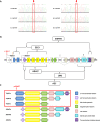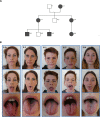Familial cleft tongue caused by a unique translation initiation codon variant in TP63
- PMID: 34629465
- PMCID: PMC8821562
- DOI: 10.1038/s41431-021-00967-x
Familial cleft tongue caused by a unique translation initiation codon variant in TP63
Abstract
Variants in transcription factor p63 have been linked to several autosomal dominantly inherited malformation syndromes. These disorders show overlapping phenotypic characteristics with various combinations of the following features: ectodermal dysplasia, split-hand/foot malformation/syndactyly, lacrimal duct obstruction, hypoplastic breasts and/or nipples, ankyloblepharon filiforme adnatum, hypospadias and cleft lip/palate. We describe a family with six individuals presenting with a striking novel phenotype characterized by a furrowed or cleft tongue, a narrow face, reddish hair, freckles and various foot deformities. Whole-exome sequencing (WES) identified a novel heterozygous variant, c.3G>T, in TP63 affecting the translation initiation codon (p.1Met?). Sanger sequencing confirmed dominant inheritance of this unique variant in all six affected family members. In summary, our findings indicate that heterozygous variants in TP63 affecting the first translation initiation codon result in a novel phenotype dominated by a cleft tongue, expanding the complex genotypic and phenotypic spectrum of TP63-associated disorders.
© 2021. The Author(s).
Conflict of interest statement
The authors declare no competing interests.
Figures


References
-
- Sutton VR, van Bokhoven H. TP63-related disorders. GeneReviews®:Seattle (WA);1993. - PubMed
-
- Rinne T, Hamel B, van BH, Brunner HG. Pattern of p63 mutations and their phenotypes-update. Am J Med Genet Part A. 2006; 140. https://pubmed.ncbi.nlm.nih.gov/16691622/. - PubMed
-
- Vanbokhoven H, Melino G, Candi E, Declercq W. p63, a story of mice and men. J Investig Dermatol. 2011; 131:1196–207. http://www.sciencedirect.com/science/article/pii/S0022202X15352878. - PubMed
Publication types
MeSH terms
Substances
LinkOut - more resources
Full Text Sources
Medical

